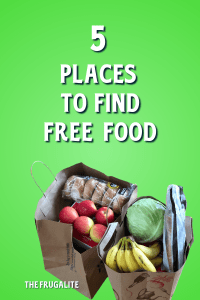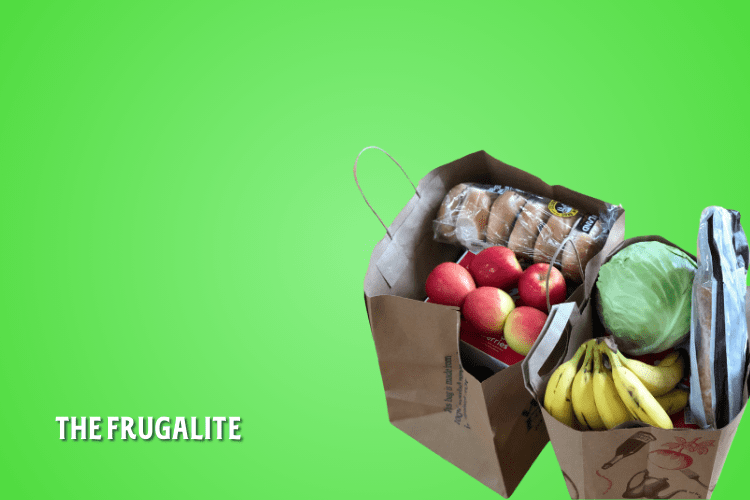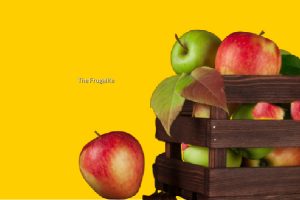(Psst: The FTC wants me to remind you that this website contains affiliate links. That means if you make a purchase from a link you click on, I might receive a small commission. This does not increase the price you’ll pay for that item nor does it decrease the awesomeness of the item. ~ Daisy)
By the author of the FREE online course Growing Self-Sufficiency: The Whole Picture
It’s all over the news these days that people are facing a squeeze when it comes to buying food. In our area, one example says it all: butter has almost doubled in price in the past couple of years. Yes, almost doubled! Extend that out to all other items, and you get the picture. Where is all of this extra money supposed to come from to buy food to eat?
In support of Frugalites everywhere, I thought I would put my thinking cap on and focus on places that I have found free food in the past or places that I am aware could have it. This article is part of a two-part series on tips to help you find free food when you need it. Now, remember what they say about that free lunch? Well, the same could probably be said about free food in general.
So, keep in mind, dear Frugalite, that many of these ideas will require either some time or some elbow grease to reap the benefits. If you have some suggestions from your own neck of the woods, please add them in the comments at the end of the article!
High-End Grocers and Bakeries
High-end grocers are invested in catering to customers who want perfect produce that is perfectly fresh. You can benefit from this tendency by saving big money when items go to clearance in these stores, all the way to even getting food for free.
When looking for discounts and free food, it pays to be friendly and ask questions. In the big city I was living in a while back, the woman who worked in the bakery of an upscale grocery store saw that I was looking for some clearance items, and we started chatting. She then shared a tip with me. At 7pm, all fresh bread was required to be put on clearance. If there wasn’t already a sticker on it, we could ask for one. Similarly, in another high-end grocery store down the road from there, all premade sandwiches went 50% off after a certain time. This store also had a clearance rack with HUGE markdowns on gently ripe produce.
 If I lived in that city and needed food, I would definitely target these high-end stores. I would talk to the manager. If clearance items don’t sell, would they be willing to sell them to me for a further discount on a weekly basis? Their extras may be given to an organization like Second Harvest, and this could help you connect with free food, too, by finding out where it is going. If the store doesn’t appear to be donating anything, and you are in great need, here is a great article by Lyza with tips about how to proceed with checking out the possibility of gleaning from their dumpsters.
If I lived in that city and needed food, I would definitely target these high-end stores. I would talk to the manager. If clearance items don’t sell, would they be willing to sell them to me for a further discount on a weekly basis? Their extras may be given to an organization like Second Harvest, and this could help you connect with free food, too, by finding out where it is going. If the store doesn’t appear to be donating anything, and you are in great need, here is a great article by Lyza with tips about how to proceed with checking out the possibility of gleaning from their dumpsters.
A True Story: A friend of mine told me that he used to drive to the grocery store in a nearby small town to pick up bins of free food. This was not even a high-end store, just your regular, run-of-the-mill, small-town grocery store. He got this food to feed his pigs. However, he told me that much of the produce was nearly perfect, such as an apple with a small nick on it. He said that you wouldn’t really believe what they were planning to throw in their dumpster. Saying that you are giving the food to your pigs might circumvent any concerns that the grocery has about giving their throw out food to humans….I’m just sayin’!
Soup Kitchen
If you are going through a difficult time, there can be unanticipated benefits to eating at a soup kitchen, especially if you may not be able to afford a lot of meat. One local program in a nearby city has a full sit-down meal in what used to be a well-known fancy restaurant. Every night there is a meat option on the menu, such as lasagne or hamburgers.
The visitors vary from working people on their own struggling to get by paycheck to paycheck, elderly folks on a limited income, and some folks housed in a nearby shelter. This place has a great sense of community and support. Everyone is welcome. The stress of financial struggles can be daunting, but seeing some friendly faces over a good meal might boost your spirits.
Many of these places need volunteers. I used to help run a clothing program for them, collecting winter coats and boots from friends and family. I also enjoyed talking with the visitors during the afternoon coffee time. Often, they would invite me to stay and enjoy the evening meal. The food was quite good and included a selection of desserts. In another city, I helped prepare the vegetables for a monthly free meal at a church, doing some of the more time-consuming tasks like peeling and chopping squash. I was always invited to stay for a meal there, as well.
Leave One/Take One Programs
A local café has a peg board on the wall by the dessert case. On it are cards labeled with items such as; “coffee,” “breakfast sandwich,” and “dessert.” If someone is in need, they can simply pick up one of these cards and cash it in for some free food. When times are better, they can buy an extra when they stop in and help a neighbor in need. If your local café doesn’t have one of these programs, perhaps you could suggest the idea! I think this works best with a smaller, locally-owned business.
Food Bank
When paying rent is a struggle, using a food bank can free up some cash. In our own little township, the fastest-growing demographic of food bank users is double-income families with children. This is not something I expected I would see in my lifetime.
So, if you are considering using a food bank for the first time, you are not alone in your struggles. Get some help with food and take the pressure off even a bit. I volunteered with a food bank in a large city. Volunteers were also offered a selection of some really nice bonus items as a thanks for their help. Check it out in your locale and see what’s possible.
Churches
At holiday times, many of our local churches offer food hampers to help families in need celebrate with a nice meal. Outside of that time, I know that our local church-run thrift shop has a small emergency food bank on the premises to give food to anyone in need, no questions asked.
This same church gives out over 50 bag lunches per week (sandwiches, veggies, drinks, and pieces of fruit) and also around the same number of frozen meals/cold plates (seasonal), which are funded by the United Way. People need not attend their church to receive assistance. Some churches here run their own food bank or can give a gift certificate to a local grocery store.
Free Food Can Help Pay the Rent
During these difficult times, getting some free food can be a relief. Could you see yourself trying any of the tips offered here to access free food? Do you have one you can share with us? Please tell us in the comments below.
About Colette
Colette is passionate about sharing her knowledge of thrifty living and self-sufficiency. She has developed her skills in self-reliance living in the suburbs, the city, and more recently, on her own Half-Acre Homestead. Colette lived five years completely off-grid and without running water in an eight by 24 foot tiny home while designing and building her own 18 by 24-foot eco-cabin. Her website, Half Acre Homestead is attracting followers from around the world who want to become more self-sufficient. Colette invites you to stop by the Homestead and check out all of the great resources including the practical How To Guides, A Tiny Home Resource Center and her organic gardening stories on her blog. She shares her wholistic model (body/mind/spirit) for achieving self-sufficiency in her Free Course, “Growing Self-Sufficiency: The Whole Picture.” Stop by the Homestead today to register free of charge!











14 thoughts on “5 Places to Find Free Food”
Years ago, I volunteered at a social service agency run by a confederation of the churches in our small Texas town. A couple of retired men made weekly stops at a grocery store to pick up produce they were discarding and brought it to the agency to give out with sacks of non-perishables. When there was more than could be distributed (and sometimes there was lots), the director would allow the volunteers to take some home. The same was true with bakery items from the store. The perishables had to go by Friday, since we were closed on the weekends and there wasn’t refrigeration space to store it.
Also, some restaurants/cafes allow workers to eat for free. My mother worked 10 hours a day at a Mexican restaurant during the Depression. She earned $1.00 per day + tips (which were few) and 2 meals a day. Adjusted for inflation, that’s $21.84 in 2024.
Hi Carla, These are great tips. I have always found that volunteering and/or working in relation to food often leads to some food. That is quite the story about your mother’s work during the Depression. Even with what seems to be a small amount, I imagine that she was likely the envy of many to have that job. Thank you so much for sharing with the Frugalite community!
Many grocery stores have a section where food at the “sell by dates” are about to pass will sell for huge savings. Also food that some consider to be specific to certain holidays will be marked down drastically. The week after Thanksgiving I was able to buy canned pumpkin for 25 cents a can!
Hi Mary, Good for you! What a great price on the pumpkin you got! Thank you for sharing these helpful tips for everyone. Much appreciated!
If you are anywhere that has a Produce on “Wheels Without Waste” group, you usually get a free produce box if you agree to help out on a Saturday morning. It’s usually just a few hours of work and the box is generally fifty or sixty pounds and quite a good variety of fruits and vegetables. My particular location charges $20 for a box but they always need volunteers. I know Tucson and Phoenix AZ have them, but there are elsewhere in the US. The same type of program might be available in other forms, so a search for “produce rescue” might be useful.
Hi Redbranch, It is always so fantastic to have programs like “Wheels Without Waste” shared that folks might be able to look up and benefit from. Thank you. It is also great that you have taken the time to mention cities that offer the program. I was so impressed to hear how big that box was. A family could really benefit from such a hefty box of food…all for a few hours of work. If anyone tries this out, please let us know in the comments!!!
Sadly free or nearly free does not always mean safe and healthy. A staple for countless millions of people (including me) is rice that tastes good and can be stored indefinitely. However there are source quality problems that retailers hate to discuss. In the US former cotton fields in southern states have been converted into rice-growing properties. The arsenic in those lands was of little significance because nobody ate cotton, but rice today is a different story. There are multiple YouTube videos explaining ways to reduce the amount of arsenic in such rice but it’s up to you to determine the source of the rice to learn if there’s a hazard. Some rice comes in packages with no origin listed but sometimes there’s a phone number from the retailer. S/he may or may not know the rice source or maybe is unwilling to disclose it to you. My personal rule is “no source? no sale.”
The only US exception to those former cotton field problems is rice from California. I found Lundberg Farms from California at Walmart that provides an arsenic-free rice … even if priced a little higher than rice from other US origins.
Then this last May of 2024 a news bombshell struck. While the article’s title doesn’t specifically mention rice … the article text does.
Over 400 Indian Food Products Contaminated With Cadmium, Pesticides, And Fungus: Report, 14 May 2024
https://greatgameindia.com/over-400-indian-food-products-contaminated-with-cadmium-pesticides-and-fungus-report/
However that article has now been mostly blanked out for people unwilling to subscribe. BUT back when that article was new …. archive.org did a snapshot of the entire article which is easy to read completely here:
https://web.archive.org/web/20240523100728/https://greatgameindia.com/over-400-indian-food-products-contaminated-with-cadmium-pesticides-and-fungus-report/
To say the least that article shook my confidence in my local India Bazaar grocery which has an entire aisle stocked full of many different brands of rice.
The point of my long rant about rice quality is that when rice is available either free or really cheap it’s up to you to determine its origin and whether it is safe to eat or whether it may have nasty contents which you may or may not be able to remove.
–Lewis
OH MY! Your comment had me running to check the origin of the bag of rice I just bought. Even though it’s marked organic, I wonder about it. Thanks for the heads up! This really is concerning and I do only generally buy organic products from India, but a related article makes it clear that some of the products marked “organic” were also contaminated. Thank you for sharing this valuable information, both about the rice in the US and also these products from India. Saddening, maddening, but also much appreciated, Lewis!
During gardening/harvesting season (July/August where I live), it isn’t uncommon to see produce at the roadside with a “FREE” sign next to it. Sometimes, people just can’t eat or can one more cucumber or zucchini and they’re happy to share their excess produce bounty and see someone eat it rather than have it go to waste.
Hi Katy, Yes!!! There is one lovely local lady who keeps an old table outside her home with produce for folks in our village to help themselves. Thanks for the tip. You never know what kind of food you might find out on a drive! Much appreciated!
Heh; out here in the rural parts of North Carolina, we like to joke that in the summertime, you’d best be careful to lock your car doors when you’re at church on Sunday if you don’t want to return to find someone has dumped a lot of free zucchinis and/or yellow squashes into your back seat. (Not everybody likes those things, and they typically grow like weeds in everyone’s backyard gardens around here.)
Hi RK, Yes ha ha ha! I have one I need to unload right now. Would you like it? I am eating them one after the other. I cut out the seeds and saute the soft part, skin on. It’s quite delicious and fills me up. I often add an onion and whatever tomato is about to become too ripe. I think somewhere on the Frugalite is an article I wrote about how to use them up. These days, I’m coming to like them more and more! Thanks for the chuckle!!!
Some of these sources kinda feed into each other. Case in point: I’m not sure whether things work the same in other states, but here in North Carolina, food banks and the organizations that run them (such as Second Harvest) are the supplier hubs in the bigger cities where the food is gathered and shipped out while soup kitchens and food pantries such as the one in the small town where I volunteer a couple days each week are the distribution outlets. In addition to the monthly shipments from Second Harvest, my particular food pantry also has a partnership with a local grocery store which gives us all its past-the-sell-by-date bread and pastries and produce and the like to hand out to our clients, doubtless in return for a bit of a tax write-off on its unsold stock.
The sell-by date is not quite the same thing as the expiration date, so a lot of the food is still quite fit for human consumption when we get it. For the stuff that isn’t, however, the pantry also has a kind of under-the-table deal worked out with one of the regular clients who’s also a farmer with pigs and chickens to feed. While the pantry has an old van it uses to drive the garbage to the dump at the end of the week, we never lock the back doors on it (as there’s nothing of any value in there for anyone other than that farmer); so on Thursday afternoon after we close for the week, he typically comes and scoops up anything his chickens or pigs might be able to eat into his pickup truck.
In addition to all this, we volunteers come from local churches (all denominations; mostly Baptist and Presbyterian with a bit of Methodist and the occasional Pentecostal thrown in) and most churches host a food drive every year to gather donations for the pantry. So, that’s basically three of your five sources who are distributing free food (and occasional drink; the grocery store has sell-by dates for its milk and juice and soda and the like too) through our pantry. While I don’t know of any soup kitchens out here in the sticks, some of those local churches also occasionally host free community meals for the poor.
It may also interest you to know our traffic at the food pantry is up significantly this month, with a lot of our new clients being families of poor-and-yet-respectably-employed people whose paychecks simply aren’t stretching far enough to make ends meet anymore. No matter how government statisticians and propagandists may dress up their figures to try to paint a rosy picture of this economy, the fact is people have less money and more debt than they used to, and their money isn’t buying as much as it once did. While we’ve been able to accommodate this surge in new traffic through our food pantry so far (i.e. no one has been sent away empty-handed as yet), if institutions like our food pantry get so overwhelmed that they no longer have anything left to give anyone, that’s when you’ll know the economy’s collapse is complete.
Hi RK, Thank you for taking the time to share such great details about your locale. I love the way the food network is all interconnected…all the way down to the local farmer getting scraps and unusable food for the chickens and pigs. Things have gotten pretty bad out here in our neck of the woods. A local church group is sending out 50 bag lunches out through their thrift shop and probably another 50 cold plates in summer (in winter its frozen stews and such). The lunches are covered by the thrift shop earnings and United Way chips in for the other meals. Some double income families with children are now using the food bank. Very much appreciate a detailed picture from North Carolina! Thanks again!